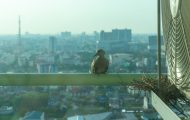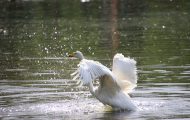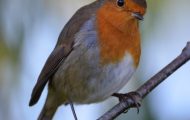Are you struggling to keep your prized fruit tree alive? Want to know how to keep birds away from your trees? Then continue reading to discover our top tips for protecting your fruit trees from birds.
Birds play an essential role in seed dispersal; they eat berries and fruits, digesting the fleshy parts before passing the seeds along with their droppings.
As birds can travel short distances quickly, the seeds can germinate and grow in new areas without competing with the original plant for light and water.
However, birds can cause serious damage to your gardens – particularly fruit trees. If you’re fed up with this happening to you, then you’re in the right place!
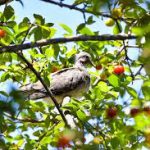
What Types of Birds Are Attracted to Fruit Trees
Before we look at controlling the bird problem in your garden, it is helpful to discover which types of birds may be causing you problems. Knowing the offending breeds means we can be more effective in controlling or proofing the area.
Many birds eat primarily frugivorous diets, including:
- Robins
- Blue Jays
- Waxwings
- Starlings
- Orioles
- Thrashers
- Finches
- Wrens
- Starlings
While other types of birds, such as Thrushes, Sparrows, Pigeons, Warblers, Woodpeckers and Tits, will also eat fruit occasionally, although it’s not commonly the main component of their diets.
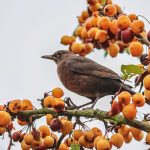
Why Are Birds Attracted to Fruit Trees?
So now we know which birds to look out for, it’s worth understanding why they may be frequenting your garden.
Fruit and berries are excellent energy sources for birds all year round. They contain high sugar levels, great for quick bursts of energy and maintaining body temperatures in the colder weather.
As well as this, berries are a vital food source as the temperatures drop. Fruits and berries will grow all year round, depending on the tree, of course. This means they are ideal for birds which usually eat worms or small insects in the ground; during colder weather, the land becomes too hard for birds to dig for food, so instead, they turn to berries!
How to Deter Birds From Your Fruit Trees
It’s clear to see that berries and fruit trees are important food sources for all types of birds. However, upon entering your garden, not only will these birds steal your berries, they will damage your plants to get to them while also leaving behind a trail of excretion wherever they go.
To protect your garden, we’ve put together our tried and tested methods for deterring birds from your fruit trees.
Before we get into those, it’s worth mentioning that birds are clever and crafty creatures who will catch onto your methods quickly. We suggest using more than one of the below methods at a time for increased efficacy.
Netting your fruit trees
One of the most common types of bird control is netting. Simply cover your fruit tree in a bird net and prevent them from getting close!
Be careful when using netting as a control method, as it can be more dangerous than it looks.
You want to make sure you purchase and use very fine netting to reduce the chances of birds squeezing through and then becoming trapped inside.
The same goes for securing the netting around the tree; ensure that the net is secured and that there are no access points around the bottom that birds and other animals can crawl under.
If a bird or small animal were to become trapped in your netting, they would start to panic, and in extreme cases, this could lead to death.
Netting is a proven and effective method for protecting specific areas from birds, but make sure you fit it correctly.
Decoy Birds
Decoy birds are essentially ornaments designed to look like birds that you can place around your garden to keep real birds at bay.
This tactic will be more effective on smaller birds as they are more likely to be scared of predators, especially if the decoy is larger than them.
There are plenty of decoy birds on the market; some even come with flashing eyes or sound effects to further scare off the pests.
It’s worth mentioning that the number of decoy birds you need depends on the size of the garden – if you have a medium-large garden, then one decoy just won’t cut it.
We suggest purchasing one or two and seeing how it goes. If birds are still landing in your garden, then try changing their positioning or buying more.
Shiny Objects in your fruit trees
An easy, DIY method used for years in bird control is placing shiny objects around your garden!
Gather shiny objects like olds CDs, DVDs, decorations, mirrors etc. and wrap twine or fishing wire around them.
Hang these items across your garden, and as the wind blows, the objects will move in the breeze and reflect light.
The sunlight reflecting on these objects will deter birds from returning to your garden as they find it threatening.
Ultrasonic Bird Repellers
A relatively new method available on the market is ultrasonic bird repellers that emit a frequency silent to the human ear but loud and annoying to birds.
This method is completely harmless to all other animals except birds, so an ideal option if you have other pets at home.
Many different versions are available, but most ultrasonic repellers can cover a large area, meaning most people will only need to purchase one.
Bird Feeders
Although it might sound silly, using a bird feeder in your garden and placing it away from your fruit trees will mean the birds are much less likely to attack your plants!
Use a bird table or hanging feeders and place tasty treats inside to encourage the birds to eat from these instead of perusing the rest of your garden.
Moving Objects
Just like the shiny objects, moving objects will also scare away most birds; so why not decorate your garden and deter the fruit-eating pests at the same time!
Use wind chimes, windmills, scarecrows, and anything else you can find. Place them around your garden, paying particular attention to your prized fruit trees, and keep the birds at bay.
Bird Repellents
The market is full of bird repellents in various forms, including liquid, gels and pellets.
They are effective; however, many carry dangers with them. If you have pets or young children in your household, it may be worth trying one of the previously mentioned methods first before you try repellants.
Some repellents are poisonous and can be harmful if ingested. Therefore, we recommend using repellants as a final option from the list if nothing else has worked.
Try out these methods in your garden and protect your fruit trees! As previously mentioned, we recommend using more than one of these methods at a time for maximum efficiency. Good luck!

